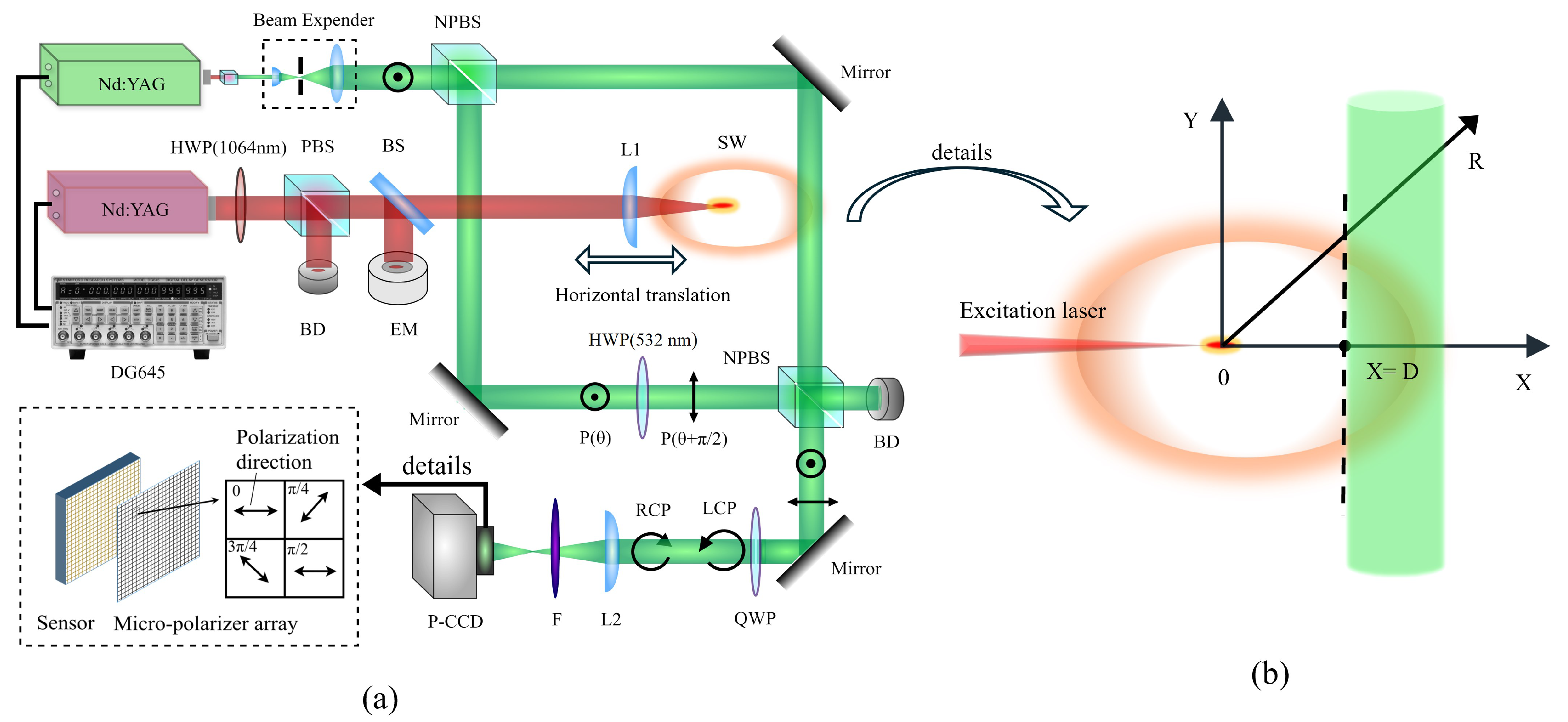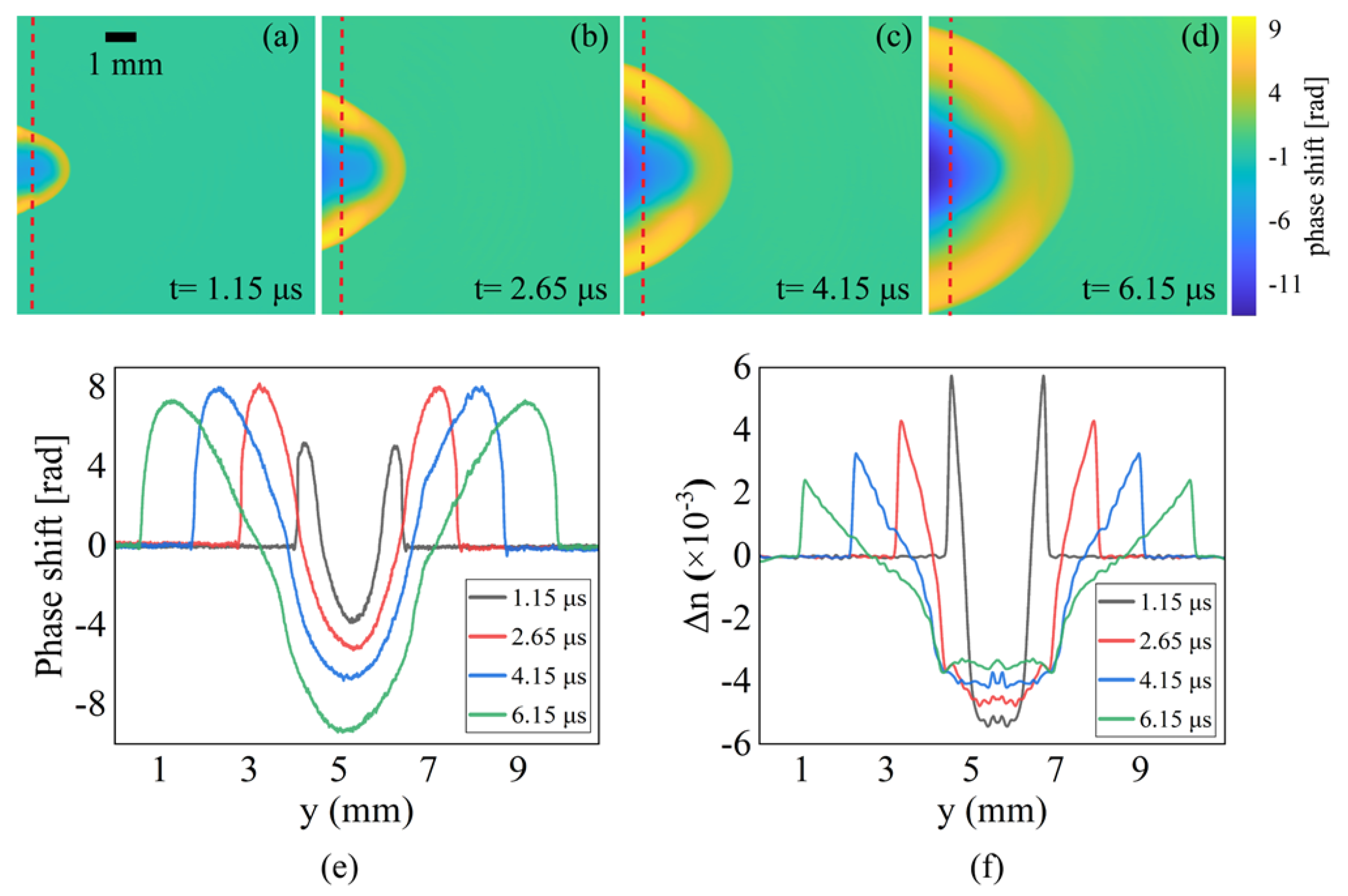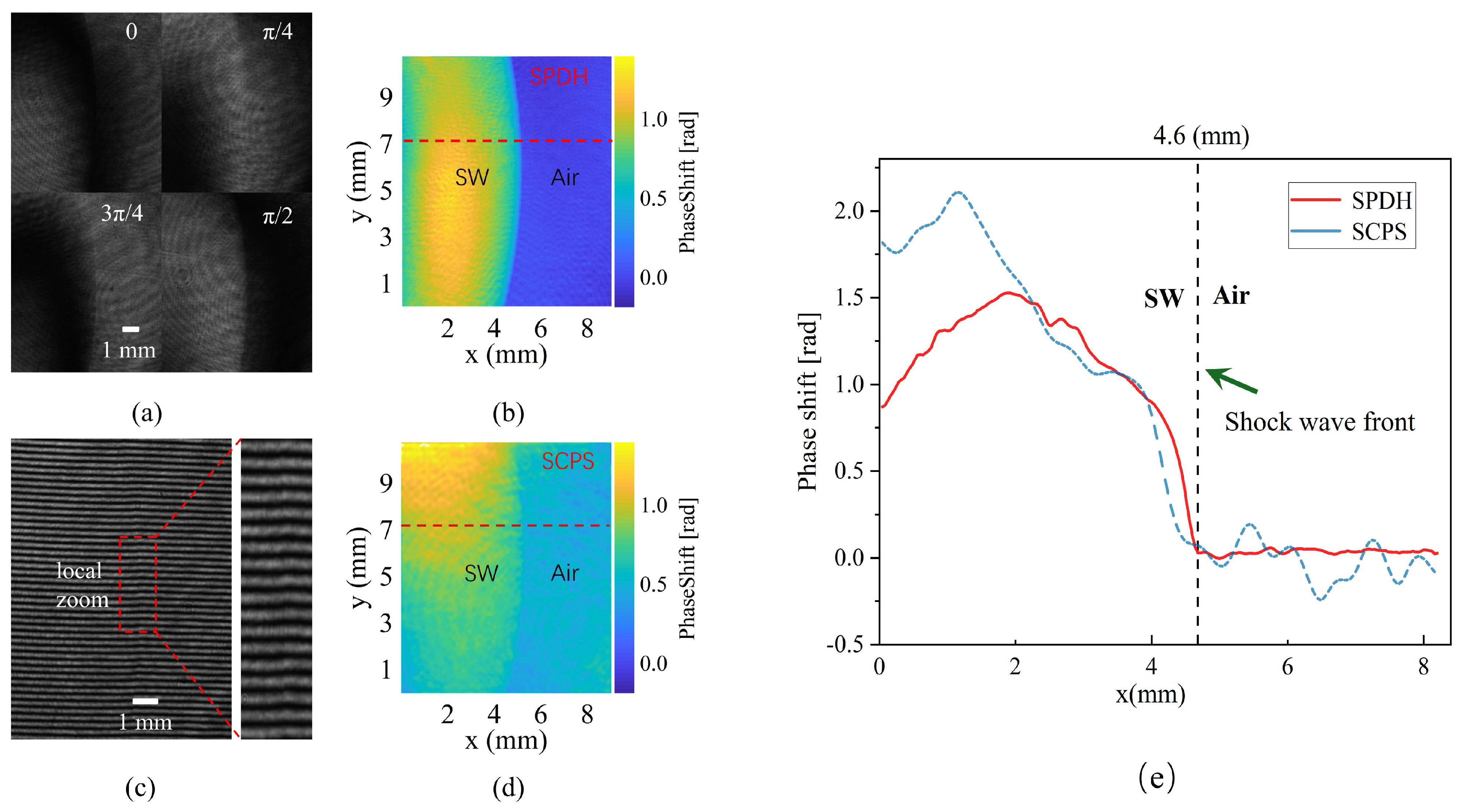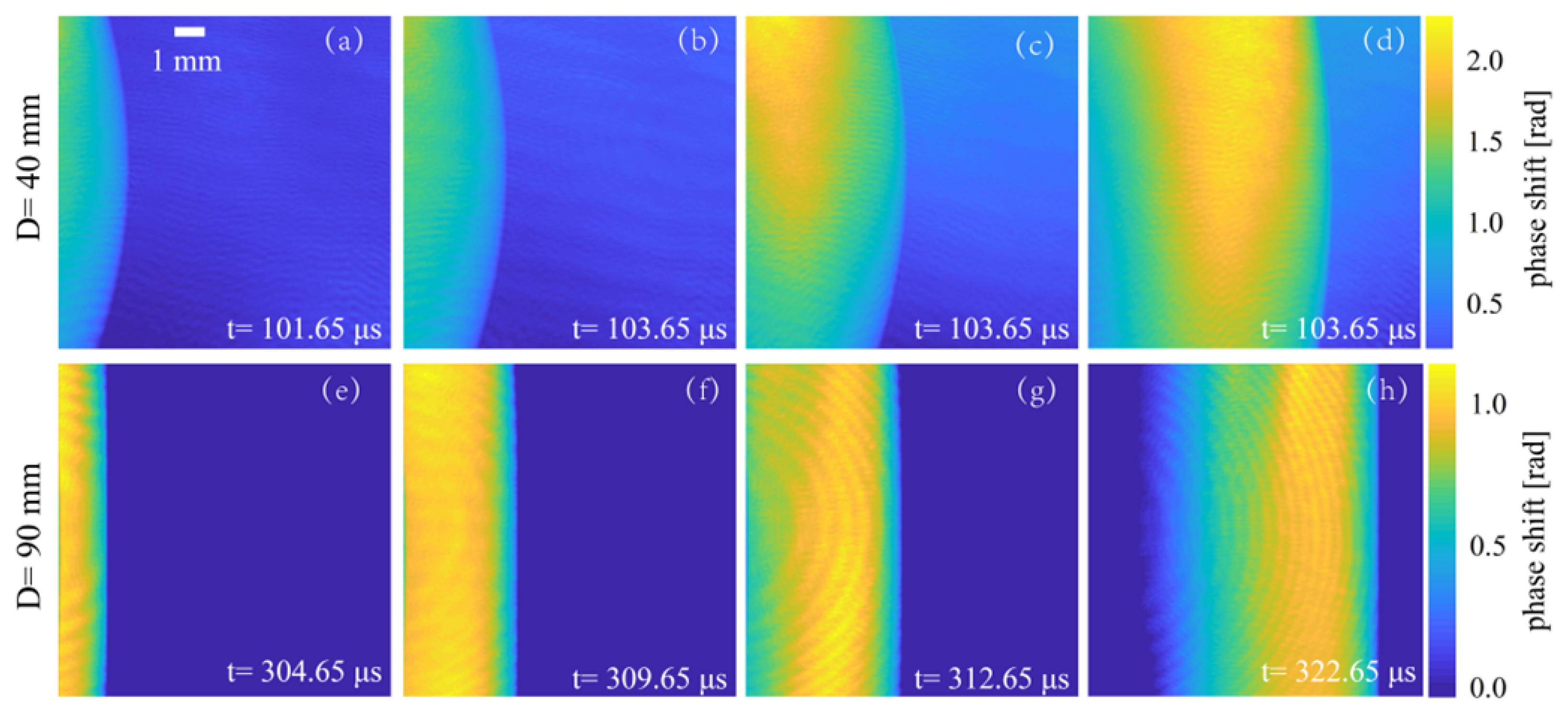High-Precision Diagnosis of the Whole Process of Laser-Induced Plasma and Shock Waves Using Simultaneous Phase-Shift Interferometry
Abstract
1. Introduction
2. Principle of the Technique
2.1. Optics Diagnosis of LIP and SW
2.2. Simultaneous Phase-Shifting Interferometry
3. Experiment
3.1. Experimental Setup and Data Processing
3.2. Data Processing and Error Calibration Method
3.3. Uncertainty Discussion and Precision Analysis
4. Results and Discussion
5. Summary
Supplementary Materials
Author Contributions
Funding
Institutional Review Board Statement
Informed Consent Statement
Data Availability Statement
Acknowledgments
Conflicts of Interest
References
- Zhou, L.; Zhu, C.; Yuan, H.; Mei, X.; Jiang, J.; Lu, Z. Influence of the laser pulse time profile on residual stress characteristics in laser shock peening. Opt. Express 2023, 31, 18039. [Google Scholar] [CrossRef] [PubMed]
- Kono, M.; Baldwin, K.G.; Wain, A.; Rode, A.V. Treating the untreatable in art and heritage materials: Ultrafast laser cleaning of “cloth-of-Gold”. Langmuir 2015, 31, 1596–1604. [Google Scholar] [CrossRef] [PubMed]
- Scott, R.H.H.; Barlow, D.; Trickey, W.; Ruocco, A.; Glize, K.; Antonelli, L.; Khan, M.; Woolsey, N.C. Shock-Augmented Ignition Approach to Laser Inertial Fusion. Phys. Lett. 2022, 129, 195001. [Google Scholar] [CrossRef]
- Dumitrescu, L.N.; Ionita, E.R.; Birjega, R.; Lazea-Stoyanova, A.; Ionita, M.D.; Epurescu, G.; Banici, A.M.; Brajnicov, S.; Andrei, F.; Matei, A. Kaolinite Thin Films Grown by Pulsed Laser Deposition and Matrix Assisted Pulsed Laser Evaporation. Nanomaterials 2022, 12, 546. [Google Scholar] [CrossRef]
- Zhang, H.; Lu, J.; Shen, Z.; Ni, X. Investigation of 1.06 μm laser induced plasma in air using optical interferometry. Opt. Commun. 2009, 282, 1720–1723. [Google Scholar] [CrossRef]
- Gregorčixcx, P.; Petkovšek, R.; Možina, J. Investigation of a cavitation bubble between a rigid boundary and a free surface. J. Appl. Phys. 2007, 102, 094904. [Google Scholar] [CrossRef]
- Liu, Y.; Penczak, J.S.; Gordon, R.J. Nanosecond polarization-resolved laser-induced breakdown spectroscopy. Opt. Lett. 2010, 35, 112. [Google Scholar]
- Breitling, D.; Schittenhelm, H.; Berger, P.; Dausinger, F.; Huegel, H. Shadowgraphic and interferometric investigations on Nd:YAG laser-induced vapor/plasma plumes for different processing wavelengths. Appl. Phys. A 1999, 69, S505–S508. [Google Scholar] [CrossRef]
- Tao, Y.; Tillack, M.S.; Harilal, S.S.; Sequoia, K.L.; O’Shay, B.; Najmabadi, F. Effect of shockwave-induced density jump on laser plasma interactions in low-pressure ambient air. J. Phys. D Appl. Phys. 2006, 39, 4027–4030. [Google Scholar] [CrossRef]
- Tao, Y.; Tillack, M.S.; Harilal, S.S.; Sequoia, K.L.; Najmabadi, F. Investigation of the interaction of a laser pulse with a preformed Gaussian Sn plume for an extreme ultraviolet lithography source. J. Appl. Phys. 2007, 101, 023305. [Google Scholar] [CrossRef]
- Sobral, H.; Villagrán-Muniz, M.; Navarro-González, R.; Raga, A.C. Temporal evolution of the shock wave and hot core air in laser induced plasma. Appl. Phys. Lett. 2000, 77, 3158–3160. [Google Scholar] [CrossRef]
- Mao, S.S.; Mao, X.; Greif, R.; Russo, R.E. Initiation of an early-stage plasma during picosecond laser ablation of solids. Appl. Phys. Lett. 2000, 77, 2464–2466. [Google Scholar] [CrossRef]
- Du, Y.; Feng, G.; Li, H.; Vargas, J.; Zhou, S. Spatial carrier phase-shifting algorithm based on principal component analysis method. Opt. Express 2012, 20, 16471–16479. [Google Scholar] [CrossRef]
- Holburg, J.; Müller, M.; Mann, K. Improved gas-jet based extreme ultraviolet, soft X-ray laser plasma source. Opt. Express 2021, 29, 6620. [Google Scholar] [CrossRef]
- Požar, T.; Petkovšek, R. Cavitation induced by shock wave focusing in eye-like experimental configurations. Biomed. Opt. Express 2020, 11, 432. [Google Scholar] [CrossRef] [PubMed]
- Jin, S.; Zhou, Z.; Sakr, E.S.A.; Motlag, M.; Huang, X.; Tong, L.; Bermel, P.; Ye, L.; Cheng, G.J. Scalable Nanoshaping of Hierarchical Metallic Patterns with Multiplex Laser Shock Imprinting Using Soft Optical Disks. Small 2019, 15, 1900481. [Google Scholar] [CrossRef] [PubMed]
- Ying, K.N.; Ni, C.Y.; Dai, L.N.; Yuan, L.; Kan, W.W.; Shen, Z.H. Multi-mode laser-ultrasound imaging using Time-domain Synthetic Aperture Focusing Technique (T-SAFT). Photoacoustics 2022, 27, 100370. [Google Scholar] [CrossRef]
- Fukuda, T.; Wang, Y.; Xia, P.; Awatsuji, Y.; Kakue, T.; Nishio, K.; Matoba, O. Three-dimensional imaging of distribution of refractive index by parallel phase-shifting digital holography using Abel inversion. Opt. Express 2017, 25, 18066. [Google Scholar] [CrossRef]
- Jiang, Z.; Wu, J.; Chen, Z.; Wang, W.; Wang, Z.; Lu, Y.; Shi, H.; Li, X.; Qiu, A. Improvement of Faraday Rotation and Its Application in Preconditioned Single-Wire Z-Pinch Plasma. IEEE Trans. Plasma Sci. 2023, 51, 944–952. [Google Scholar] [CrossRef]
- Jiang, Z.; Wu, J.; Wang, Z.; Chen, Z.; Wang, W.; Shi, H.; Li, X.; Zhang, D. Experimental study of the magnetic field and current distribution in double-wire Z-pinch. Plasma Phys. Control. Fusion 2023, 65, 085005. [Google Scholar] [CrossRef]
- Swadling, G.F.; Lebedev, S.V.; Hall, G.N.; Patankar, S.; Stewart, N.H.; Smith, R.A.; Harvey-Thompson, A.J.; Burdiak, G.C.; De Grouchy, P.; Skidmore, J.; et al. Diagnosing collisions of magnetized, high energy density plasma flows using a combination of collective Thomson scattering, Faraday rotation, and interferometry (invited). Rev. Sci. Instruments 2014, 85, 11E502. [Google Scholar] [CrossRef] [PubMed]
- Hernández, D.; López, C.P.; Santoyo, F. Application of the carré algorithm and high speed interferometer technique for fast surface profile measurement. Optoelectron. Adv. Mater. Rapid Commun. 2014, 8, 185–191. [Google Scholar]
- Li, M.; Zhang, H.; Lu, J.; Shen, Z. Investigation of the laser ultrasound propagation in K9 glass using optical interferometry. Chin. Opt. Lett. 2022, 20, 021203. [Google Scholar] [CrossRef]
- Li, M.; Zhang, H.; Lu, J.; Shen, Z. Laser ultrasonic loading and optical interference detection of closed cracks in K9 glass. Opt. Lett. 2022, 47, 3736–3739. [Google Scholar] [CrossRef]
- Sun, Y.; Zhang, H.; Pan, Y.; Lu, J. Three-dimensional measurement of a thermal lens in K9 glass using a Mach–Zehnder interferometer. Appl. Opt. 2019, 58, 6604. [Google Scholar] [CrossRef]
- Parkevich, E.V.; Medvedev, M.A.; Selyukov, A.S.; Khirianova, A.I.; Mingaleev, A.R.; Mishin, S.N.; Pikuz, S.A.; Oginov, A.V. Setup involving multi-frame laser probing for studying fast plasma formation with high temporal and spatial resolutions. Opt. And Lasers Eng. 2019, 116, 82–88. [Google Scholar] [CrossRef]
- Yamaguchi, I. Phase-shifting digital holography. Opt. Photonics News 2008, 19, 48–53. [Google Scholar] [CrossRef]
- Han, J.H.; Li, R.P.; Liu, J.H.; Hai, F.S.; Huang, M.J. Two-step phase shifting differential-recording digital holographic microscopy. Sci. Rep. 2017, 7, 1992. [Google Scholar] [CrossRef]
- Kakue, T.; Yonesaka, R.; Tahara, T.; Awatsuji, Y.; Nishio, K.; Ura, S.; Kubota, T.; Matoba, O. High-speed phase imaging by parallel phase-shifting digital holography. Opt. Lett. 2011, 36, 4131–4133. [Google Scholar] [CrossRef]
- Herráez, M.A.; Burton, D.R.; Lalor, M.J.; Gdeisat, M.A. Fast two-dimensional phase-unwrapping algorithm based on sorting by reliability following a noncontinuous path. Appl. Opt. 2002, 41, 7437–7444. [Google Scholar] [CrossRef]







Disclaimer/Publisher’s Note: The statements, opinions and data contained in all publications are solely those of the individual author(s) and contributor(s) and not of MDPI and/or the editor(s). MDPI and/or the editor(s) disclaim responsibility for any injury to people or property resulting from any ideas, methods, instructions or products referred to in the content. |
© 2025 by the authors. Licensee MDPI, Basel, Switzerland. This article is an open access article distributed under the terms and conditions of the Creative Commons Attribution (CC BY) license (https://creativecommons.org/licenses/by/4.0/).
Share and Cite
Gao, L.; Zhang, H.; Lu, J.; Shen, Z. High-Precision Diagnosis of the Whole Process of Laser-Induced Plasma and Shock Waves Using Simultaneous Phase-Shift Interferometry. Photonics 2025, 12, 601. https://doi.org/10.3390/photonics12060601
Gao L, Zhang H, Lu J, Shen Z. High-Precision Diagnosis of the Whole Process of Laser-Induced Plasma and Shock Waves Using Simultaneous Phase-Shift Interferometry. Photonics. 2025; 12(6):601. https://doi.org/10.3390/photonics12060601
Chicago/Turabian StyleGao, Lou, Hongchao Zhang, Jian Lu, and Zhonghua Shen. 2025. "High-Precision Diagnosis of the Whole Process of Laser-Induced Plasma and Shock Waves Using Simultaneous Phase-Shift Interferometry" Photonics 12, no. 6: 601. https://doi.org/10.3390/photonics12060601
APA StyleGao, L., Zhang, H., Lu, J., & Shen, Z. (2025). High-Precision Diagnosis of the Whole Process of Laser-Induced Plasma and Shock Waves Using Simultaneous Phase-Shift Interferometry. Photonics, 12(6), 601. https://doi.org/10.3390/photonics12060601




